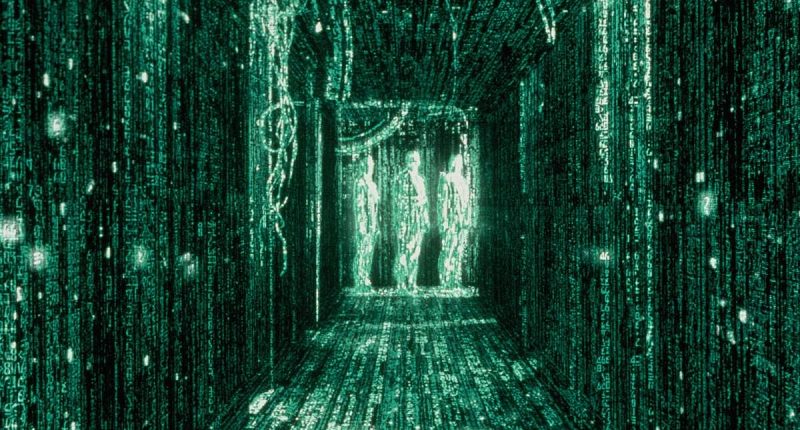Share this @internewscast.com
For more than a quarter of a century since its release, ‘The Matrix’ has fueled modern fears that life is not all it seems.
But according to a scientist, the classic movie’s premise may not be completely science fiction.
Melvin Vopson, an associate professor in physics at the University of Portsmouth, thinks gravity may be a sign that we’re all living in a virtual simulation.
Our universe is the ‘ultimate computer’, Professor Vopson theorizes in a new paper.
Gravity’s pull – both on planet Earth and in outer space – is the universe trying to keep its vast amount of data organised, Professor Vopson claims.
Forcing objects with mass into one direction – for example downwards towards Earth’s core – is similar to how computers compress code, he adds.
‘The universe evolves in a way that the information content in it is compressed, optimized and organized – just as computers and computer code do,’ he told MailOnline.
‘Hence, gravity appears to be another process of data compression in a possibly simulated universe.’

In the blockbuster movie The Matrix, protagonist Neo, played by Keanu Reeves, discovers we’re living in a simulated reality hundreds of years from now. By the end of the film, Neo is able to see the simulated world for what it is – computer code (pictured)

For over a quarter of a century, ‘The Matrix’ has fueled modern fears that life is not all it seems. But according to a scientist, the film’s premise may not be completely science fiction
The simulation theory is not unique to Professor Vopson; in fact, it’s popular among a number of well-known figures including Tesla founder Elon Musk.
But in recent years Professor Vopson has been investigating the various cues that suggest we live in a simulated reality.
His new study, published in AIP Advances, reports that gravity may be one of these everyday clues and ‘evidence of a computational universe’.
Gravitational attraction helps to reduce ‘information entropy’ – which is essentially how much information there is in an object in a given space.
The study introduces a new way to think about gravity – not just as a pull, but as something that happens when the universe is trying to stay organised.
‘My findings in this study fit with the thought that the universe might work like a giant computer, or our reality is a simulated construct,’ he said.
Professor Vopson stresses he’s not only talking about the gravitational pull we see on Earth and the ‘apple falling on Isaac Newton’s head’ moment four centuries ago.
Speaking much more widely, gravity is a fundamental force throughout our vast universe, which is commonly said to be 93 billion light-years across.

In ‘The Matrix’, a group of rebels can enter the computer simulation at will, as well as specially-designed computer programmes (pictured)

The professor is not just talking about gravity on Earth but in the wider universe, where it builds entire galaxies, pulls planets into orbit around their stars, and influences the motion of nearby objects
In space, gravity has many roles including building entire galaxies, pulling planets into orbit around their stars, and influencing the motion of nearby objects.
So, in space, matter and objects may be being pulled together because the universe is trying to keep information tidy and compressed, the theory goes.
‘To put it simply, it is easier to compute all the properties and characteristics of a single object in space, rather than multiple objects,’ he told MailOnline.
‘That is why objects in space are pulled together.’
Dr Vopson is known for formulating the principle that information is not just an abstract mathematical entity, but a ‘physical, dominant, fifth state of matter’.
He argues that information has mass and that all elementary particles – the smallest known building blocks of the universe – store information about themselves, similar to the way cells have DNA.
He thinks bits – the unit of digital information – have their own mass and energy, which has wide-ranging implications for computing technologies, physics and cosmology.
In a previous paper, the academic established a new law of physics, called the ‘second law of information dynamics’ to explain how information behaves.

This image visualises the second law of thermodynamics from the 1850s. This old law establishes that entropy – a measure of disorder in an isolated system – can only increase or stay the same. In contrast, Professor Vopson’s second law of infodynamics establishes that entropy decreases – but it explains the behaviour of information in a way that the old law cannot
His law establishes that the ‘entropy’, or disorder, in a system of information decreases rather than increases.
This new law came as somewhat of a surprise, because it’s the opposite of the second law of thermodynamics established in the 1850s, which explains why we cannot unscramble an egg or why a glass cannot unbreak itself.
As it turns out, the second law of infodynamics explains the behaviour of information in a way that the old law cannot.
‘The second law of infodynamics requires the minimisation of the information content associated with any event or process in the universe,’ he told MailOnline.
‘To put it simply, everything appears to evolve to an equilibrium state where the information content is minimal.
‘Such behaviour is fully reminiscent of the rules deployed in programming languages and computer coding.




